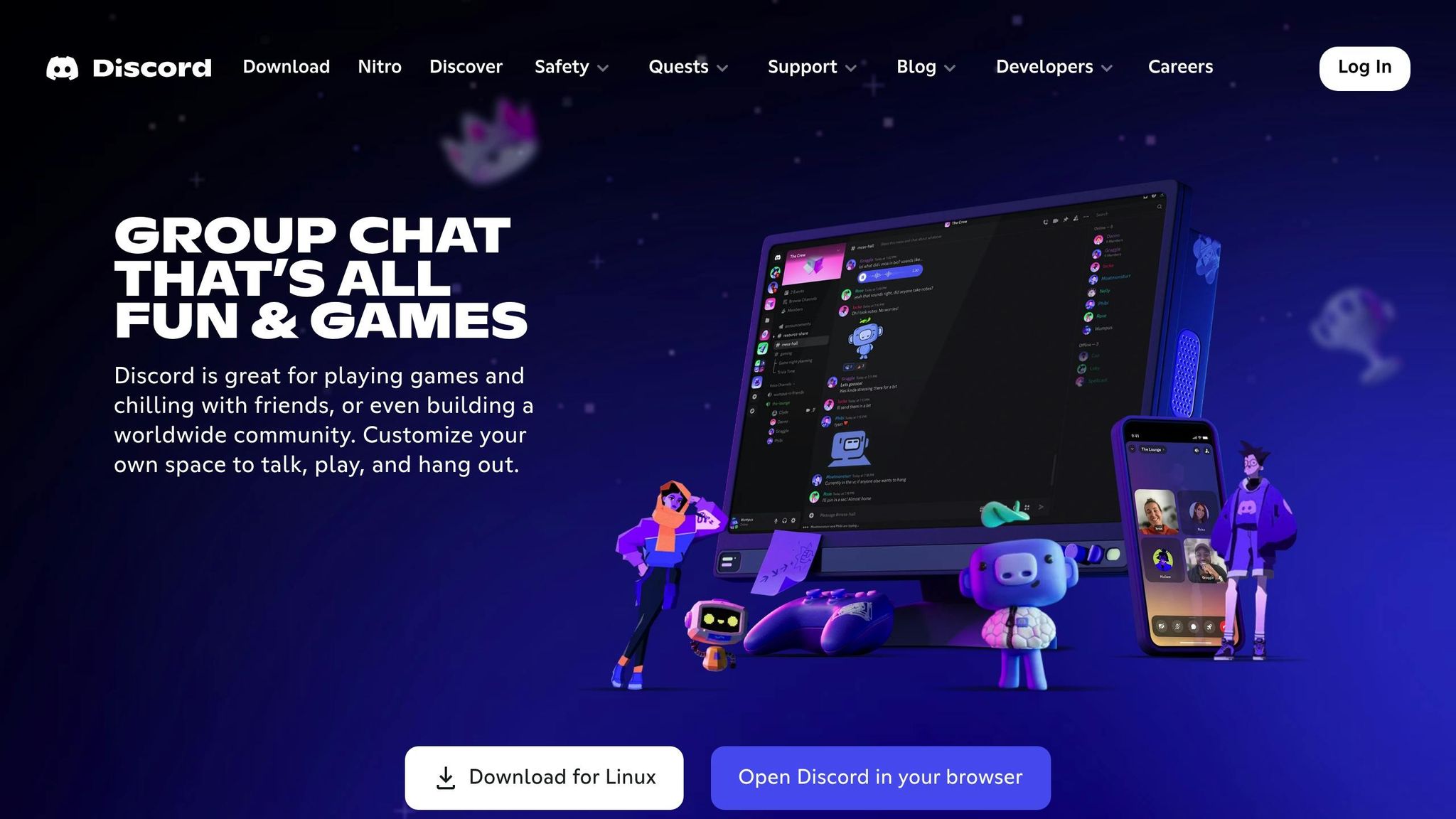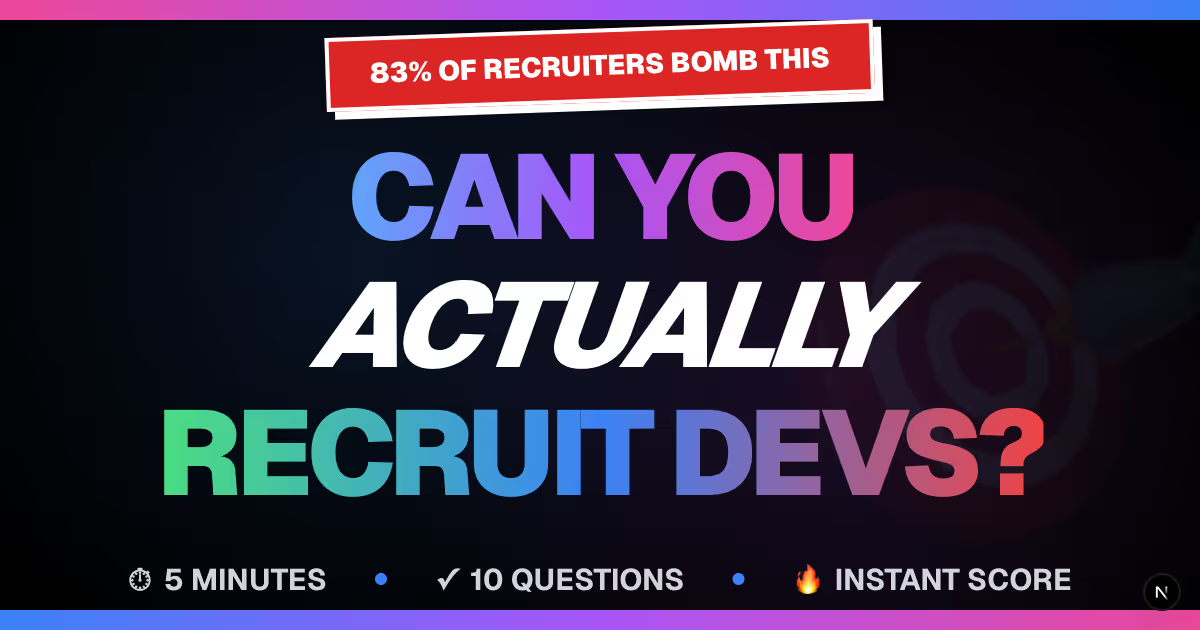


Learn effective strategies for sourcing top developers through personalized outreach, professional networks, and community engagement.
Finding top developers isn't about job boards anymore. Most skilled developers are already employed and rarely browse listings. To hire them, you need to go where they are - professional networks, online communities, and referral systems. This guide explains how to connect with developers effectively by focusing on trust, personalization, and detailed job briefs.
Key Insights:
- Developers prefer personalized outreach over generic messages.
- Professional developer networks, like daily.dev Recruiter, offer access to passive talent with high engagement rates (85–90%).
- Platforms like GitHub and Stack Overflow allow recruiters to assess technical skills through contributions.
- Employee referrals and internal talent pools are cost-effective and yield high-quality hires.
Quick Tips:
- Use developer-friendly job briefs with clear details (tech stack, challenges, and growth potential).
- Engage developers in spaces they already frequent (developer networks, online communities).
- Leverage automation tools for targeted outreach while maintaining a personal touch.
By tailoring your approach to developers' preferences and using the right channels, you can build meaningful connections and attract top talent.
Tech Recruiting Academy - Sourcing Through Discord and Slack

Main Developer Sourcing Channels
In keeping with a developer-first approach, the best sourcing channels are those that connect with talent in the environments they naturally gravitate toward. The key to success lies in reaching developers where they already are, rather than relying on outdated recruitment tactics. Each channel serves a distinct purpose, targeting different segments of the developer community.
Professional Developer Networks
Professional developer networks provide a focused way to connect with engineering talent. These platforms are designed specifically for developers, offering spaces where they can engage with industry content, sharpen their skills, and stay informed about trends.
A standout example is daily.dev Recruiter, the only recruiting platform built directly on top of a developer network. This platform taps into a global community of passive talent - individuals who are often unreachable through traditional recruitment methods. By transforming generic job descriptions into developer-friendly briefs, it discreetly presents opportunities to candidates whose skills, interests, and goals align with the role. This ensures that outreach feels relevant and respectful.
The platform also employs a double opt-in system, guaranteeing warm, pre-qualified connections. Early cohorts have seen reply rates exceeding 85–90%. Additionally, it provides detailed candidate profiles that go beyond standard resumes, offering insights into developers’ interests, career goals, and work history. This level of detail makes initial conversations more personalized and meaningful.
Outside of dedicated networks, other social platforms and community hubs can further broaden your reach.
Social Media and Online Communities
Social media platforms and online communities focused on developers present valuable opportunities for sourcing talent, but they require a thoughtful approach. These spaces prioritize technical discussions and knowledge sharing over direct recruitment pitches.
Platforms like GitHub and Stack Overflow showcase developers’ technical contributions and problem-solving abilities, allowing recruiters to engage through authentic technical discussions. Similarly, developer-focused subreddits and Twitter (now X) offer opportunities to connect with active developers, open-source contributors, and thought leaders. In these spaces, trust-building through genuine, helpful participation is crucial before initiating any recruitment conversations.
Employee Referrals and Internal Talent Pools
Employee referrals remain one of the most effective ways to find high-quality hires. Referred candidates often align well with company culture and tend to stay longer. Developers typically have extensive professional networks, making them excellent sources for referrals.
For referral programs to succeed, they need clear guidelines and transparent processes. Internal talent pools - such as previous candidates, alumni networks, and internal mobility programs - also provide valuable opportunities to tap into existing relationships while keeping hiring costs down.
Each of these channels requires a thoughtful and tailored approach, with an emphasis on building genuine relationships. When combined strategically, they create a well-rounded sourcing strategy that effectively connects with both active and passive developer talent.
How to Maximize Sourcing Success
Sourcing developers effectively isn't just about numbers - it's about building trust, crafting job briefs that resonate, and using automation to streamline processes. When done right, these steps turn recruitment into a relationship-driven effort that attracts the best talent.
Let’s dive into how to make it work.
Building Trust with Passive Candidates
Trust is the cornerstone of recruiting developers, especially those who aren't actively job hunting. These passive candidates are often flooded with recruitment messages, making them selective about who they engage with.
One effective approach? Warm, double opt-in introductions. This method ensures that conversations begin with mutual interest and respect, leading to reply rates as high as 85–90% when applied correctly.
Personalization is another big piece of the puzzle. Developers can spot a generic message a mile away, and it signals a lack of effort. Instead, reference specific projects they’ve worked on, technologies they use, or contributions they’ve made to open-source communities. This shows you’ve taken the time to understand their skills and interests, not just skimmed their resume.
Timing and context also play a critical role. Rather than interrupting developers with unsolicited messages during their workday, successful recruiters connect with them in spaces where they’re already professionally active. It’s about meeting them where they are.
Finally, clarity is key. Developers want to know upfront about the role’s technical challenges, team dynamics, and growth potential. Being transparent from the start shows respect for their time and helps avoid mismatched expectations down the line.
Writing Job Briefs Developers Want to Read
Generic job descriptions don’t cut it for developers. They’re not motivated by vague requirements - they care about technical challenges, the tools they’ll use, and how their work will make an impact.
A developer-friendly job brief needs to provide all the context upfront. Go beyond listing basic qualifications and dive into the specifics: What’s the tech stack? What architectural challenges will they tackle? How will their work influence the product and its users? This level of detail allows developers to quickly decide if the role aligns with their goals.
For example, instead of saying "experience with modern frameworks", be precise: "React 18 with TypeScript, Node.js backend, PostgreSQL database, deployed on AWS using Docker containers." This paints a clear picture of the day-to-day work.
It’s also important to address the finer details that might not make it into public job postings. Things like remote work policies, on-call expectations, or opportunities for technical leadership can be deal-breakers for some candidates. Including this information upfront avoids misunderstandings later, which are often cited as a major issue in recruiting.
Some platforms can even take your standard job description and transform it into a developer-friendly brief for you to review. This ensures accuracy while tailoring the language to what developers care about most.
One thing to avoid? Vague, inauthentic, or overly generic descriptions. Developers consistently call out these issues as major turn-offs. Instead, focus on clear, honest communication about the role’s challenges, growth opportunities, and learning potential.
A well-written brief not only attracts the right candidates but also sets the stage for efficient matching through automation.
Leveraging Automation Without Losing the Personal Touch
Automation in recruitment doesn’t mean losing the human element - it’s about using technology to handle repetitive tasks so you can focus on meaningful interactions.
With advanced targeting tools, you can reach developers based on specific criteria like skills, career goals, seniority, programming languages, and even location. Integration with applicant tracking systems (ATS) ensures candidate information is automatically updated and avoids duplicate entries. This kind of precision ensures your outreach reaches the right people instead of casting a wide, unfocused net.
Automated screening tools can also save time by pre-qualifying candidates with custom questions that go beyond what’s on their resumes. This ensures candidates meet the role’s requirements and helps identify those who are the best fit.
The key to effective automation is maintaining a personal, developer-first approach. Platforms that operate within developer networks can facilitate warm introductions automatically, preserving the trust and context that make these connections meaningful. Instead of cold emails or endless screening calls, this approach creates trust-based connections that feel genuine.
When done right, automation enhances human judgment rather than replacing it. It allows recruiters to scale their efforts while respecting developers’ preferences, resulting in better matches and stronger relationships.
sbb-itb-d1e6221
Developer Sourcing Channel Comparison
Choosing the right sourcing channels is a crucial step in building a developer-first hiring strategy. Each channel brings its own strengths and challenges, influencing how effectively you can engage with candidates and meet recruitment goals. By understanding these differences, you can allocate your resources wisely and tailor your approach to fit your hiring needs.
Below is a table comparing key sourcing channels and their effectiveness in various aspects of recruitment:
Sourcing Channel Comparison Table
| Channel Name | Access to Passive Talent | Candidate Quality | Engagement Rate | Cost | Typical Use Case |
|---|---|---|---|---|---|
| Professional Developer Networks (e.g., daily.dev Recruiter) | Excellent – 90% won't reply elsewhere | High – 40% senior ICs & leaders | 85–90% reply rate for double opt-in introductions | Minimum spend of $5,000 for targeted ad campaigns | Sourcing senior developers and specialized technical roles |
| Social Media Platforms | Good | Variable | Low (often due to cold outreach) | Varies | Broad candidate discovery |
Professional developer networks, like daily.dev Recruiter, are specifically designed to foster trust with developers. For example, daily.dev connects with 1 in 50 developers globally, and an impressive 90% of them are unlikely to respond elsewhere. Moreover, 40% of its users are senior individual contributors or leaders. This combination of trust and quality results in higher engagement rates and better candidate matches compared to other channels.
On the other hand, social media platforms provide a wider reach but often struggle with lower engagement, primarily due to the impersonal nature of cold outreach. While they can help discover a broad range of candidates, they may not always deliver the depth of engagement needed for specialized roles.
For many tech companies, blending these two approaches can be a game-changer. Professional developer networks offer targeted, high-quality engagement, while social media platforms provide the reach to tap into a wider pool of talent. Together, they create a balanced strategy that caters to both niche and general hiring needs, laying the groundwork for a more comprehensive and effective recruitment plan.
Conclusion and Key Takeaways
Final Thoughts on Developer Sourcing
The game has changed when it comes to sourcing developers. It's no longer about sifting through endless resumes or sending out cold emails. Today, successful recruitment is about building trust and making meaningful connections. Developers are looking for roles that not only match their skills but also align with their career aspirations and personal values. Platforms like daily.dev Recruiter are leading the charge by meeting developers where they already are - within their digital communities. This approach fosters genuine engagement and creates opportunities that truly resonate.
The takeaway is straightforward: quality beats quantity. Instead of bombarding developers with generic messages, top recruiters are honing in on targeted, thoughtful outreach. By focusing on what matters to developers, from their interests to their values, companies can craft a recruitment strategy that feels personal and effective.
Next Steps for Recruiters
Take a moment to assess whether your current approach aligns with what developers actually want. Relying on cold outreach or generic job boards could mean missing out on up to 40% of senior developers who are active on specialized platforms.
To shift gears, replace impersonal outreach with tailored, warm introductions. This simple change can elevate response rates from single digits to an impressive 85–90%. Streamline your process by integrating your sourcing tools with your Applicant Tracking System, eliminating redundant tasks and ensuring that pre-qualified candidates move seamlessly into your hiring pipeline. Lastly, invest time in crafting job descriptions that speak directly to developers. Highlight opportunities for growth, provide detailed insights into the tech stack, and showcase the unique aspects of your engineering culture. These steps can make all the difference in attracting and engaging top talent.
FAQs
How can recruiters make their outreach to developers feel more personal and relevant?
Recruiters can make outreach more personal by offering clear context about the role and explaining how it connects to the developer's skills and interests. Taking the time to reference the developer's past work, specific expertise, or professional aspirations in each message shows a sincere effort to connect. This kind of tailored communication not only builds trust but also highlights that the opportunity was carefully considered with their profile in mind.
What should a developer-focused job brief include to attract top talent?
A well-crafted job brief for developers needs to start with a straightforward role description. Clearly outline the responsibilities and the skills required, making sure to specify the technologies and tools they’ll be using. This helps candidates quickly assess if the role aligns with their expertise.
Be upfront about workplace expectations, including the team structure, work culture, and any opportunities for growth. Adding context about your company’s mission and how the role contributes to it can make the listing more relatable and engaging. Skip the generic buzzwords - focus on what makes the position and your company stand out.
To streamline the process, consider including screening questions. Keep them simple but effective at gauging a candidate’s suitability, ensuring they aren’t overly time-consuming. A thoughtful, tailored job brief not only attracts interest but also encourages applications from the right candidates.
How can you use automation in developer recruitment while keeping it personal?
Automation simplifies the recruitment process for developers by handling tasks such as resume screening and matching candidates to roles. However, to keep the process personal and engaging, prioritize tailored communication, provide clear and transparent updates, and ensure introductions are mutually agreed upon through a double opt-in system. This strategy fosters trust and creates meaningful interactions, helping developers feel appreciated and connected throughout their hiring journey.
Related Blog Posts








